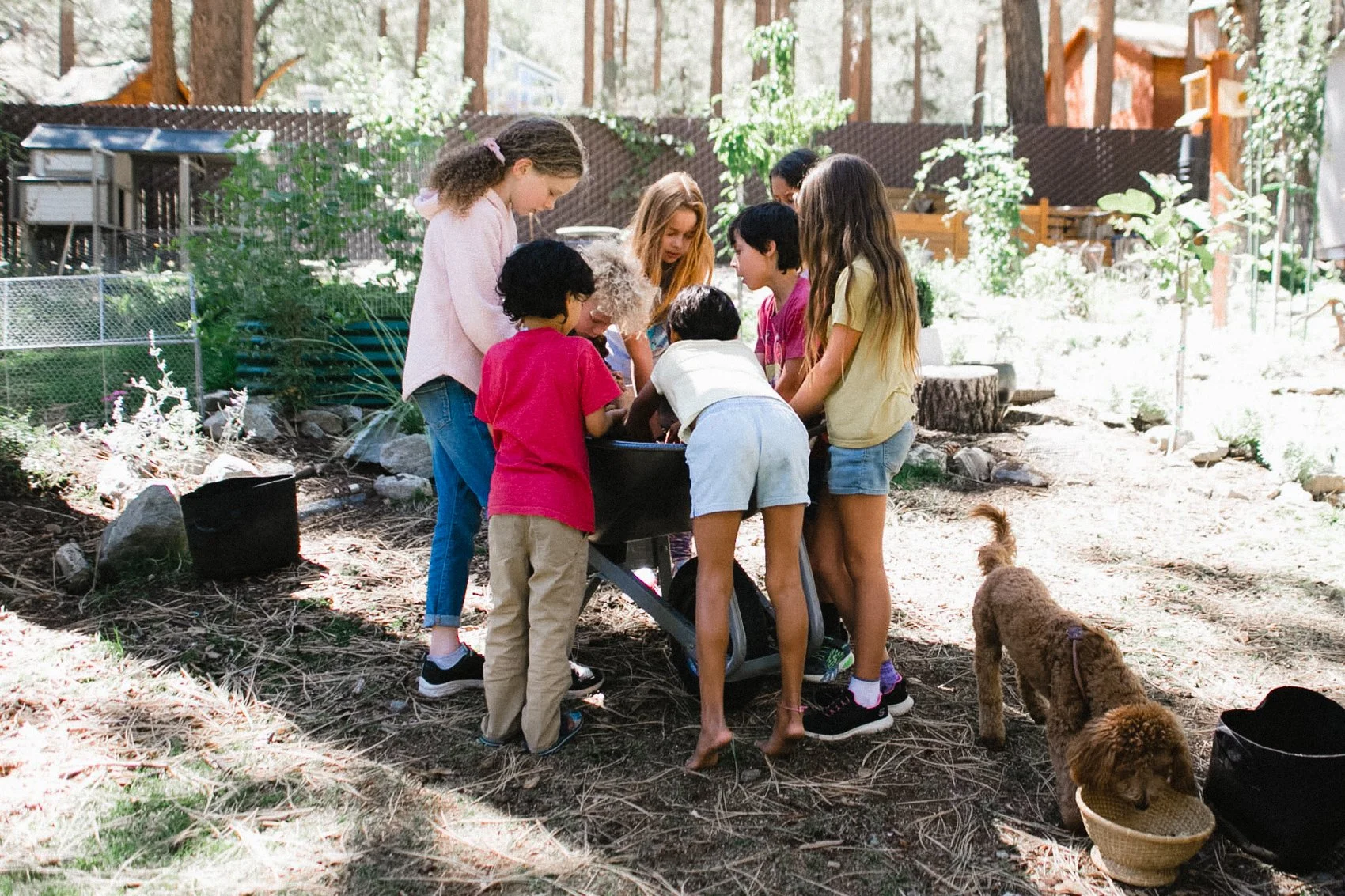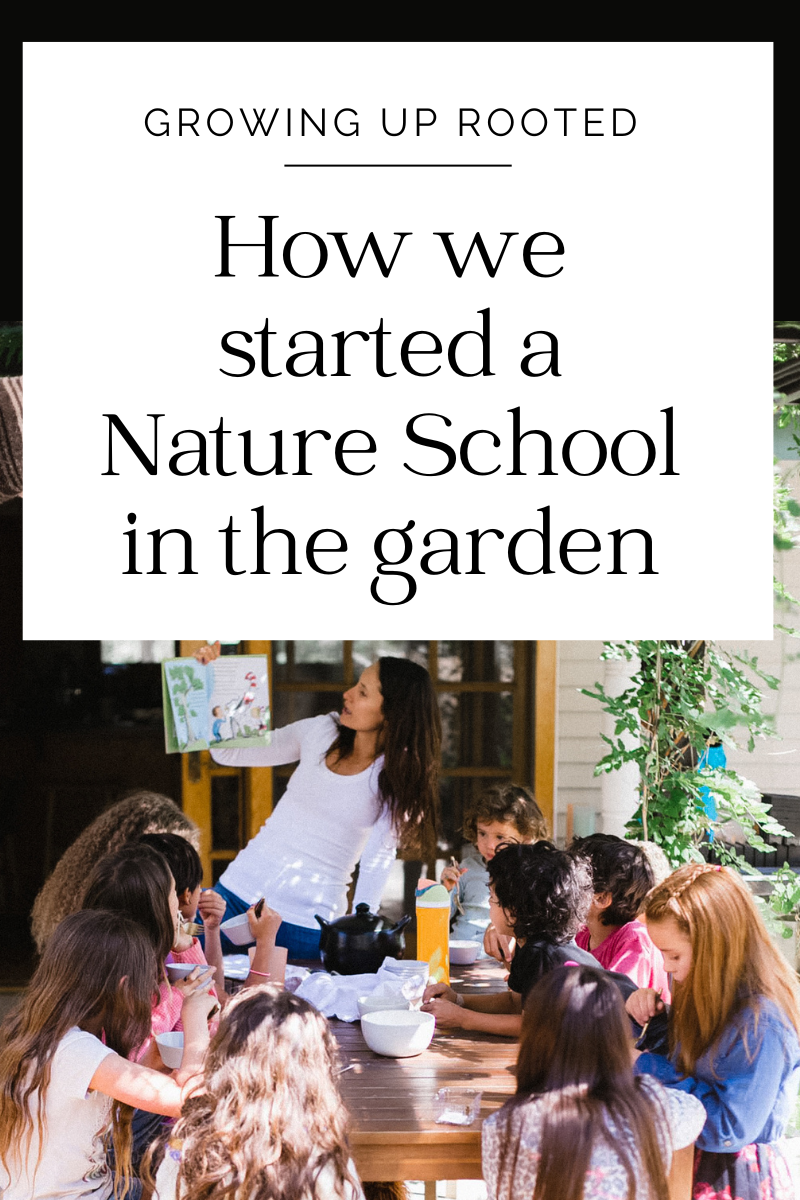How we started a Nature School in our garden
Nature School was the first project of what later became Growing Up Rooted. We are now an apothecary and community space as well, but above all our goal is to raise the next generation of people forever Rooted in Nature. This is how we started.
Fall session kids observing the progress of a garden planted in the Spring session.
The beginning of Nature School
Back in 2020, when the pandemic hit, we decided to ditch the city and move to this little town called Wrightwood, in Southern California. It was a special move because we had never lived outside of a big city, and for the first time for me and the girls, we were going to experience the full cycle of the four seasons including snow.
As we looked for houses a plan began to form in my mind. We were new homeschoolers and I had a vision for a space filled with books and arts inside and abundance of nature outside. I wanted the outdoors to be our school just as much as the dinning table would. And a dream to start a Nature School was formed.
I knew that if I wanted the girls to love the outdoors, and ultimately welcome other homeschool children to enjoy it with us, I needed to find a way to really to make outdoor living a big part of my own life first. As we searched for our home a few things became really important:
We needed land. We wanted to live within walking distance to the main town area so we weren’t planning for acres of land, just a good quarter acre would do, and that’s what we luckily found.
A door to the back yard through the kitchen was a must. I knew that in order to make the outdoors part of our house, we needed easy access to the back yard. It needed to be visible and I imagined a door from the kitchen would make it more accessible. We found a house with two big sliding glass doors to the back yard from the communal space. The perfect situation for summer outdoor living when we go in and out with ease, can see the yard from every indoor space, and leave the doors open as a constant invitation.
Outdoor living spaces. Right outside of the kitchen and dinning areas, in the back yard, there’s a small deck. I knew that was the perfect space for summer meals and school and art projects.
Once we moved into our new space, I began to plan our garden. We began by dividing the yard into areas, mulching the ground to help it come to live after being eroded and sunbaked. I first planted fruit trees in a little grove at the end of the yard, then other young trees joined the garden, as well as smaller perennial plants and a single raised bed for vegetables. By the next year, we had enough of an outdoor space that it felt right to offer our first Nature School session and I was amazed at the response. Registration opened and closed in a matter of one week and there it was, Nature School was a reality!
A group of kids at nature school digging for potatoes in a pile of soil.
What is Nature School?
For us, Nature School came to mind as I realized nature sciences was the most fun for us to study. We started having nature study dates in the city were we visited a park, explored and journaled our findings. It was fun and we truly enjoyed our time together. Nothing like the constant eyer-rolling and snack requesting experience of studying math and language arts at the table!
Once we decided to move to this mountain town, the idea evolved into creating a space at our home for kids to come together, learn, explore and practice community in nature. With my experience in gardening and herbalism, I knew that life outdoors is the best life. The question was how to offer a space outdoors that would inspire children to learn and connect with nature in the ways I have grown to enjoy.
With the support of books and online resources, mostly focused to forrest school and tinker gardens, I came up with a basic idea: Class has evolved over time, but at its core it remains the same. We host two sessions every year, Spring and Fall. This way we are able to experience first hand, and through all our senses, the transition that happens from Winter to Spring as the garden wakes up, and Summer to Fall as it goes back to sleep. We meet once a week for two hours in our garden. Every day there’s a topic to learn and discuss, we share a meal that I cook at home, we read a book and explore each topic with all our senses through activities, games and garden walks. We allow enough space for friendships to develop and conflicts to be resolved. We share in community and slowly witness the shifts that happen in the garden.
Our little school features vegetable beds (we now have 5 beds and enough space to grow food to share with the class), fruit trees (over 7 varieties as of today), free-range chickens, a thriving compost pile, earthworm farms and our dog Bowie. This environment provides a hands-on, immersive learning experience for all of us and we love it.
Children making earthworms out of clay in a thriving summer garden.
What are our main goals with Nature School?
1. GARDENING
We spend time outside, getting our hands dirty, helping food grow from seed to plate.
At Nature School, children have the opportunity to engage with the natural world in a way that is both educational and fun. They can learn about plant growth and cultivation by tending to the vegetable beds and fruit trees, and gain an appreciation for the life cycles and behaviors of the free-range chickens and the rest of the life forms that make our ecosystem complete.
A student of nature school harvesting kale to make soup with the group.
2. SCIENCE
We come to understand how this ecosystem functions, and what role we play in it.
In addition to gardening and animal care, Nature School also offers a variety of nature-based activities and lessons. These may include small nature hikes in the forest behind our property, wildlife observation, and environmental stewardship projects, all designed to foster a love of the outdoors and a respect for the natural world.
Students exploring an earthworm farm in the garden.
3. BIODIVERSITY
We are commited to regenerative and organic practices. Without using pesticides and trusting the wisdom and balance of nature.
Our garden is alive and thriving because we focus on supporting soil and biodiversity. To us that means never using pesticides, instead, we work on getting deeply acquainted with our ecosystem, so we can support a healthy balance of plants and creatures alike. We honor and respect everything that lives in our garden and in the process we learn important lessons about patience, loss, life and death, stewardship to the land, and community
Students learning about harvesting seeds in the fall.
With its focus on experiential learning and connection to the natural world, Nature School has proven to be a unique and enriching educational opportunity for us and the other homeschooled children that join us every session.
Nature School days are our favorite and the sound of children in the garden has become one of my most cherished life memories to date.
Every day starts with a book on the topic we’re discussing. The kids enjoy healthy meals cooked by me while they listen.
Love, Daniela
Photography thanks to Michelle Scharfe from Research Parent.












